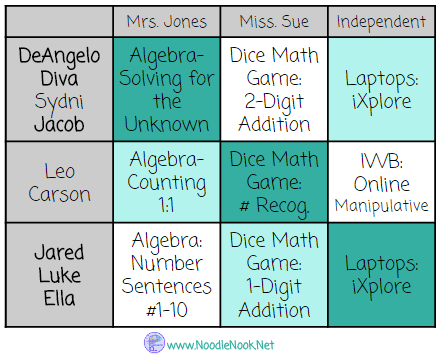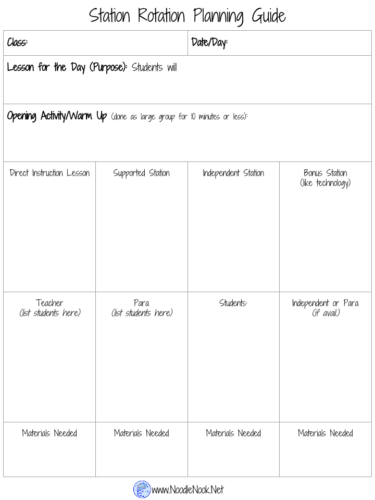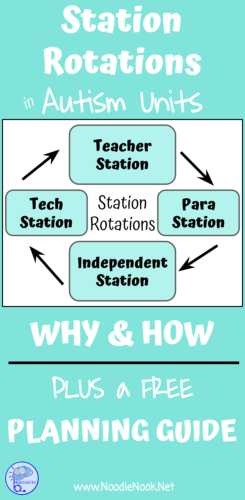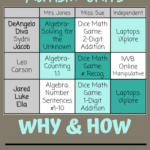Station Rotations in Autism Units and LIFE Skills
Station Rotations are a must for anyone in a self-contained classroom.
It’s overwhelming. Do you ever sit in your classroom and look around and just feel overwhelmed? The paperwork and data and documentation are almost an entire job in and of themselves. Then, on top of that, you’re supposed to be teaching and differentiated and modifying materials so your students are working on meaningful materials in the classroom. All of that is overwhelming. So how do you make sense of it? How do you make it all work? The key, in my opinion, is station rotations in Autism Units and in LIFE Skills.
Large Groups Just Don’t Work
There is no way you can stand in front of a group of autistic students or students in a life skills classroom and think you’re going to lecture them into learning.
It’s just not a possibility.
Now I’ve had naysayers claim that they teach this way and it works just fine. I challenge you to think of the last time you sat in a lecture.
Were you engaged?
My guess is you were multitasking and that’s what kept things engaging. You were working on something else in the background. Most of our students aren’t able to do that effectively. In the background they’re gearing up for behaviors or sensory stimulation. They aren’t making this week’s grocery list.
So how do you get them more engaged?
The answer station rotations.
Why Station Rotations?
What do station rotations look like in a life skills classroom or Autism unit?
You are undoubtedly working with students who need a lot of repetition in order to learn, maintain, and generalize a skill. You can cater to that by using small groups during your instructional time. Delivering your first time instruction or teaching a new skill and a small group is far more effective than trying to do that with lots of students.
That seems like a no-brainer!
Structure your class so that you can work with two three four or even five students at once instead of all of them in a large group.
[tweetthis]Station Rotation in Autism Units: How and Why + Free Planning Guide![/tweetthis]
How Does it Look?
So what about the rest of the kids?
What are they doing while you are delivering first time instruction or teaching a new skill?
Hopefully you have some support staff in your classroom, and they are able to take another small group and repeat lessons, review information or skills, or reiterate key ideas drawn out of your first time instruction. Our kids don’t always get the big idea the first time and need to review it more than once. Doing that as a station as part of your station rotation model will give them a chance to solidify learning as well as give your paras an opportunity to work with a small group as well.
If you have more than one paraeducator in your classroom, you have a chance to make several smaller groups. But what if it’s just you and one other adult in the room? What do you do then? The answer is independent workstations.
 Independent Workstations?!?
Independent Workstations?!?
Whatcha talkin’ ‘bout Willis?
Yeah, I said it.
Independent workstations.
In order to make any self-contained classroom operate correctly there must be activities that students can work on independently.
Don’t misunderstand, I don’t live in a fantasy land. I understand not all students can work independently for substantial amounts of time. But we have to work into our stations and rotations activities that allow us to build stamina and increase the amount of time a student does work with minimal supervision. Sometimes these activities are ones that they repeated to the point that they can replicate without support. Sometimes these activities are more leisure skills-based. The point is that during a 10, 12, or 15 minute station rotation a student is able to be independent.
Station Rotations = Engagement!
When I do classroom visits, I tend to see teachers who are working at 100,000% while the people around them are working a fraction of that. And the students are only sporadically engaged.
By implementing the station rotation model the teachers tend to feel like they’re working less and being more effective, while the paras are able to take more ownership in the room and the students are infinitely more engaged. This is a win-win-win!
How Do I Start Station Rotations?
So what do you do now?
How do you get started with the station rotation model in your classroom?
The easy answer is to take what you’re doing now and break it into three groups.
Say you are doing a worksheet. With some students who are more able, you might find you typically give them the worksheet and allow them to work on that worksheet for 20,30, or 40 minutes with an adult as support who tends to spend a lot of time redirecting the students.
Imagine if you broke that up.
Maybe that student or group of students spend 10 minutes getting some good instruction from the teacher, then spends 10 minutes getting some supported instruction from the paraeducator (like monitoring as they work and redirecting like usual), and then spend these students spend 10 minutes practicing on their own with minimal redirection as needed.
TaDa! Station rotations.
Some students may get their independent time first while others start with the para supported station. The truth is it doesn’t matter who goes first or last in the beginning… The key is to take what you’ve got and start small with station rotations. You’ll find it becomes very clear what works and what doesn’t work, where are you need more materials, and how you need to guide your students and staff to make it all work.
So grab a timer, set it for about 10, 12, or 15 minutes, and start your station rotations today!
 Need a planning guide?
Need a planning guide?
Check out this Station Rotation Guide FREE!






Hi There, what an informative and wonderful article. Helped me a lot with my problem. Like the details you have pointed out. Completely true!
Pingback: Special Ed Classroom Setup Ideas | NoodleNook.Net
Comments are closed.